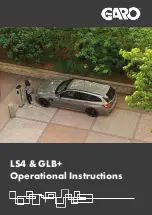
•
7
•
7. FOLLOW THESE STEPS WHEN BATTERY IS OUTSIDE VEHICLE
A SPARK NEAR THE BATTERY MAY
CAUSE A BATTERY EXPLOSION. TO
REDUCE THE RISK OF A SPARK NEAR
THE BATTERY:
7.1
Check polarity of battery posts. POSITIVE
(POS, P, +) battery post usually has a larger
diameter than NEGATIVE (NEG, N, –) post.
7.2
Attach at least a 24-inch long 6-gauge
(AWG) insulated battery cable to
NEGATIVE (NEG, N, –) battery post.
7.3
Connect POSITIVE (RED) charger clip to
POSITIVE (POS, P, +) post of battery.
7.4
Position yourself and free end of cable as
far away from battery as possible – then
connect NEGATIVE (BLACK) charger clip
to free end of cable.
7.5
Do not face battery when making final
connection.
7.6
When disconnecting charger, always do
so in reverse sequence of connecting
procedure and break first connection
while as far away from battery as
practical.
7.7
A marine (boat) battery must be removed
and charged on shore. To charge it on
board requires equipment specially
designed for marine use.
8. GROUNDING AND AC POWER CORD CONNECTIONS
8.1
This battery charger is for use on a
nominal 120 volt circuit and has a
grounded plug. The charger must be
grounded, to reduce the risk of electric
shock. The plug must be plugged into
an outlet that is properly installed and
grounded in accordance with all local
codes and ordinances. The plug pins
must fit the receptacle (outlet). Do not use
with an ungrounded system.
8.2 DANGER:
Never alter the AC cord or
plug provided – if it does not fit the outlet,
have a proper grounded outlet installed
by a qualified electrician. An improper
connection can result in a risk of an
electric shock or electrocution.
NOTE:
Pursuant to Canadian
Regulations, use of an adapter plug
is not allowed in Canada. Use of an
adapter plug in the United States is not
recommended and should not be used.
8.3 USING AN EXTENSION CORD
The use of an extension cord is not
recommended. If you must use an
extension cord, follow these guidelines:
•
Pins on plug of extension cord must be
the same number, size, and shape as
those of plug on charger.
•
Ensure that the extension cord is
properly wired and in good electrical
condition.
•
Wire size must be large enough for
the AC ampere rating of charger, as
specified:
Length of cord (feet)
25
50
100 150
AWG* size of cord
16
14
10
8
*AWG-American Wire Gauge
9. ASSEMBLY INSTRUCTIONS
9.1
Remove all cord wraps and uncoil the cables prior to using the battery charger.
10. CONTROL PANEL
VOLT/AMP SELECTOR SWITCH
Use the volt/amp selector switch to select
the charge rate or engine start setting.
•
10A Fast or 30A Rapid Charge –
For charging automotive, marine and
deep-cycle batteries. Not intended for
industrial applications.
•
200A Engine Start –
Provides additional
amps for cranking an engine with a
weak or run-down battery. Always use in
combination with a battery.
TIMER
The timer allows you to set a specified
time for charging. After the timer expires,
the charger stops charging your battery.
The main function of the timer is to prevent
overcharging, while allowing a battery time
to obtain a satisfactory charge. To properly
set the timer, you must know the size of
the battery (in ampere hours) or reserve
capacity (in minutes) and the state of
charge. It is important that you determine
the appropriate state of charge of your
battery and set the timer accordingly.








































